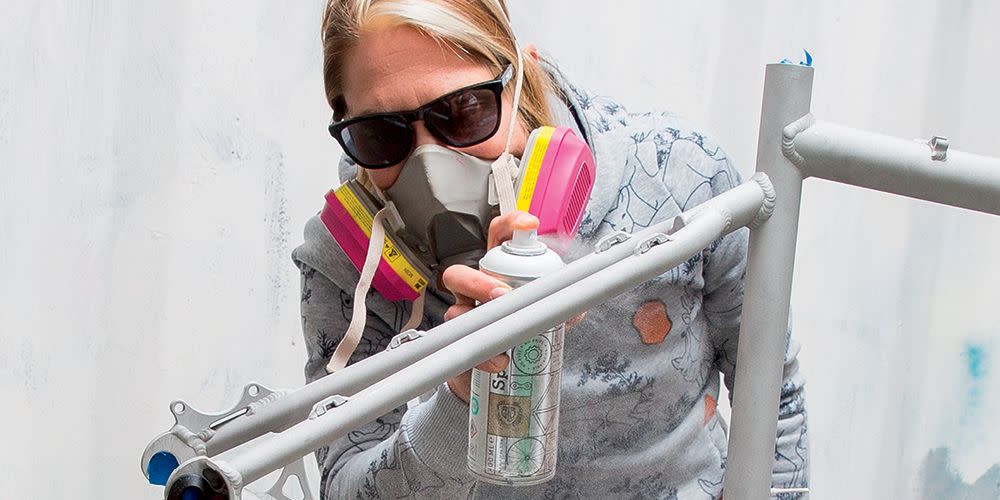These 6 Bike-Painting Tips Will Let You Give Your Ride a Custom Look

"Hearst Magazines and Yahoo may earn commission or revenue on some items through the links below."
British cycling coach Juliet Elliott shows how to paint a bike above in a video featured on Squidbikes.com.
“I’m racing a bike with ice cream on it,” says Emily Kachorek. “You don’t have to like it, but I do. And at least it makes you turn your head!”
Kachorek, an elite cyclocross racer, former biologist, and the cofounder of Squid Bikes, discovered her creative side early. “As a kid I was always building bows and arrows and slingshots,” she says. Now she gets paid to spray paint bikes in eye-popping patterns and create cycling kits that stand out even when they’re covered in mud.
Squid started in part because of a screwup. In 2013, Kachorek worked with a bike company to design a frame to match her then-neon kit—but the paint job came back the wrong shade of yellow. She asked the owner of the brand if she could fix it herself. “I decaled the shit out of the frame,” she says, laughing. “It was neon vomit. It looked different than everything else out there. I wondered if I’d be embarrassed on the start line.”
Instead, Kachorek discovered that people were digging her bold and playful style. She and her Squid Bikes cofounders sourced American-made aluminum frames and started spraying. “I’m a child of the ’80s; I love neon obnoxious things,” Kachorek says. “I realized that bikes don’t look like this. They’re black and red and white and blue. I like to think we’ve helped that culture evolve a little.”

Kachorek founded Squid to not just share her own vision, but also to let other riders express theirs: The company sells several frames (as well as framesets and different builds) that customers can finish themselves, or you can have Squid Bikes paint the frame for you. Squid also sells ‘Sprayed n Ready’ frames that they painted, but never built up. (They’re usually from trade shows, but sometimes they sell frames painted by featured artists.)
One of Kachorek’s favorite bikes of all time was a Creamsicle-and-cloud design that came to her in a dream. She painted the frame in front of an audience at a gravel road race to show how easy the process can be. “It’s our way of having fun and not taking everything so seriously,” she says. “It’s not going to be perfect, but it’s going to be yours.”

6 Tips for How to Paint a Bike
Whether you’ve always wanted to try your own custom paint job on your bike, or you’ve recently dusted off your bike because of COVID-19, a fresh look for your ride is always a great idea. Along with advice from Kachorek, we’ve put together some tips for making your paint job a successful one.
1. Practice First
If this is your first time painting a bike, or if you’re using a different paint than last time, you might want to practice. You can experiment on a cheap frame that you won’t mind messing up, or even a cheap metal tube.
2. Prep the Bike
You’ll want to make sure that the frame is ready to be painted. First, clean it with rubbing alcohol and a lint free towel. Make sure that the frame is completely clean. If it’s not raw aluminum, steel, or carbon, give it a light sanding so the paint has something to stick to. Use 1,000 to 1,500-grit sandpaper, and rub just enough to texture the surface—you don’t want to take any material completely off.
3. Pick Your Paint
It’s important to pick a high-quality paint that’ll last, so check out your local art stores. Look for a low-pressure can—the more slowly the paint comes out, the easier it is to work with. Squid sells their own paint, Spray.Bike, on its website, and Montana paint is another good option. Whatever you end up picking, don’t mix brands or lines, as different paints can react poorly together.
4. Break Out the Tape
Put painter’s tape over parts of the frame that will have components attached: bottom bracket, seat tube, head tube, and dropouts. Kachorek says 3M Scotch Blue Exterior works well on Squid’s aluminum frames. You can use tape to mask off areas of the bike while creating your design as well—just make sure your base layer is completely dry, or the paint might peel off with the tape.
5. Set Up Your Work Station
Though doable, it’s a hassle to paint your bike while holding it, so you should secure your frame so you can paint it without touching it. You can wedge the head tube onto a dowel and clamp the dowel into a stand, or just thread string or twine through the top tube and hang it from a rafter. You might want to lay down a drop cloth, too, to catch any overspray.
6. Spray Away
First, Kachorek says to shake the can for three minutes before using it. Then, check the can to see how far away you should hold it while spraying. (Spray.Bike should be held closer to the bike than other paints, between one to four inches away.) Paint should be sprayed on evenly and with one coat at a time. Keep your hand moving at a steady pace while spraying, too.
Take the weather into consideration as well. Kachorek recommends painting in dry weather (most importantly), and preferably in warmer temperatures and low humidity. Make sure to give the paint enough time to dry between layering different colors or adding a second coat.
And play around! The beauty of DIY is that there are no wrong answers. If you need more advice on painting your bike, check out the painting tips on Squidbikes.com.
You Might Also Like

